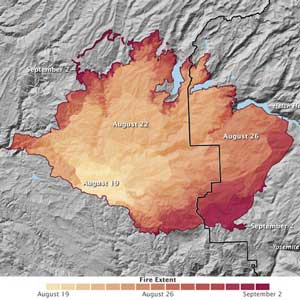By Betsy Mason from wired.com:
Last week we posted a map of the Rim fire’s progression into Yosemite National Park from Inciweb. That map (see below) uses random, qualitative colors to represent the area burned by the fire each day. The result is colorful, and as the headline says, frightening. The wild colors make the fire look chaotic. Once it reaches a certain size, it becomes really hard to see the progression. You can see clearly what has burned each day, but the time sequence is disguised in a random color palette.
Many of you commented on this, including Robert Simmon, Lead Data Visualizer and Information Designer at NASA’s Earth Observatory. But Simmon took it a step further and made the new map above with a sequential color scale. This makes the order of the progression much more clear — and a lot more elegant too, while managing to remain scary. The apt color choice makes the burned area look like it is one big flame.
The Inciweb map grew incrementally and is being used to follow the fire on specific days, so using vastly different bright colors that easily stand out from each other was probably a conscious decision. But Simmon’s map gives people like us who are not on the front lines a much better grasp of the life of this fire.
“I prefer a sequential palette because dates are ordered,” Simmon told me in an email. “The Inciweb palette is suited for categorical data — data which is qualitative, not quantitative. In principle you can find the date by looking at the map, then the key, then back at the map, but that’s a difficult cognitive task. It’s made more difficult because there’s more than 10 categories, which is over the limit of readily perceptible colors.”
Simmon has a ton of great information about this sort of thing on his Elegant Figures blog, including posts on this very issue of qualitative versus sequential color scales, and a whole series on the subtleties of color.
“The palette I used is ordered, like the data,” Simmon said. “You can see the overall pattern instantaneously, with the fire progressing in two directions from the starting point. In general graphics are better at showing patterns than specific quantities, so I like to play to that strength.”
There are tradeoffs, however. Simmon notes that on his map, it’s harder to see distinct days.
“Another design decision was which side of the scale to emphasize,” Simmon said. “I chose to make the later dates more intense and more saturated, since those are most current and presumably relevant. I think the map would look better with earlier dates more intense, but be less informative.”
I don’t know which I think would look better. I suppose whichever looks more like an actual flame — so, the way it is now.






